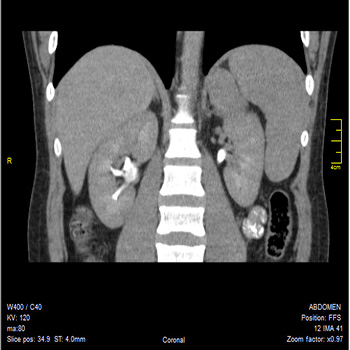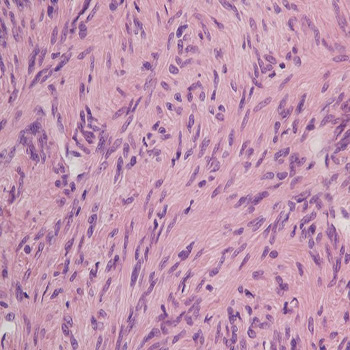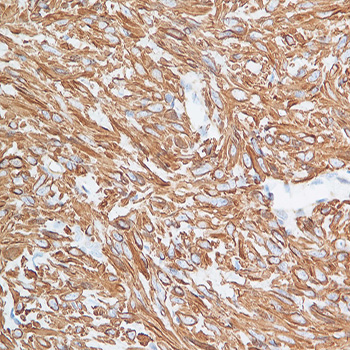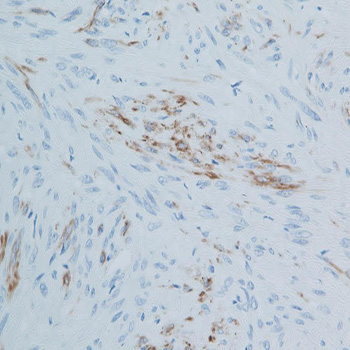Previous Issues Volume 1, Issue 2 - 2016
Adrenal Leiomyoma: A Rare Tumor Presented as an Incidentaloma in a Patient with AIDS
Marcelo Corti1,2, Luis De Carolis1,2, Lisandro o Véliz3, Ana Campitelli4, Gabriela Acosta Haab5
1Division of HIV/AIDS, Infectious Diseases F. J. Muñiz Hospital, Buenos Aires, Argentina.
2Medicine Department, Infectious Diseases Orientation, University of Buenos Aires, School of Medicine, Buenos Aires, Argentina.
3Urology Section, Infectious Diseases F. J. Muñiz Hospital, Buenos Aires, Argentina.
4Histopathology Laboratory, Infectious Diseases F. J. F. J. Muñiz Hospital, Buenos Aires, Argentina. 5Histopathology Laboratory, M. Curie Oncology Hospital, Buenos Aires, Argentina.
Corresponding Author: Marcelo Corti, Department of HIV/AIDS, Infectious Diseases F. J. Muñiz Hospital, Puán 381, 2nd Floor, C 1406 CQG, Buenos Aires, Argentina. Tel: 541144323762; E-Mail: [email protected]
Received Date: 07 May 2016 Accepted Date: 27 May 2016 Published Date: 01 Jun 2016
Copyright© 2016 Corti M
Citation:Corti M, Carolis LD,Véliz L,, Campitelli A, et al. (2016). Adrenal Leiomyoma: A Rare Tumor Presented as an Incidentaloma in a Patient with AIDS. Mathews J HIV AIDS. 1(1): 006.
ABSTRACT
Background and Aims
Adrenal leiomyoma is an extremely rare and benign tumor, usually presents as an incidental finding. Generally, this tumor is a non-functional large adrenal mass. The majority of leiomyomas of the adrenal gland are called as s“incidentalomas” because they are found in absence of clinical symptoms and represents an unexpected finding during an abdominal ultrasound or computed tomography (CT) scan. Here we describe a 40-year-old man seropositive for the human immunodeficiency virus (HIV), under highly active antiretroviral therapy who presents a heterogeneously left adrenal mass in the context of a routine ultrasound abdominal scan. A CT abdominal scan confirms this finding. Laboratory results revealed that the tumor was non-functional. Because the possibility of adrenal carcinoma, the patient underwent a successful left adrenalectomy. Histopathology examination and immunohistochemistry techniques confirm the diagnosis of leiomyoma. Adrenal leiomyoma should be included in the differential diagnosis of unilateral, non-functional adrenal tumors in HIV patients.
KEYWORDS
Adrenal Leiomyoma; Incidental Finding; HIV; AIDS.
INTRODUCTION
Incidental adrenal tumors are often diagnosed during abdominal ultrasonography or computerized tomography (CT) studies for other pathologies. In human immunodeficiency virus (HIV) infected patients, leiomyomas are described with more frequency than in the general population. Also, in AIDS patients, these tumors have been well described in association with Epstein-Barr virus (EBV) infection [1]. We report the case of an HIV-seropositive male with an inci dental adrenal mass that was diagnosed as a leiomyoma on histopathological and immunohistochemical (IHQ) studies. A literature review on adrenal leiomyoma was also made, including Pub Med, Medline and Embase for articles published until December 2015.
MATERIAL AND METHODS
A 40-year-old HIV seropositive man with diagnosis of AIDS since 2012 account of his history of toxoplasmic encephalitis. He received a complete antiparasitic treatment and after, he was started on antiretroviral therapy. In this moment, the CD4 T-cell count was 111 cell/µL and the plasma viral load was 46 120 copies/mL (log10 4, 70). Two years later, in a routine medical examination, he referred a colic pain on the left lumbar fossa. An abdominal ultrasound scan showed a large size of the left adrenal gland. A computed tomography scan of the abdomen revealed an enlarging mass of 43 x 57 mm on the left adrenal gland (Figure 1).
Figure 1: Computed tomography of abdomen showing a large left-sided adrenal mass.
Figure 2: H-E 40X: Histopathology of the surgical piece showing a fusocellular proliferation of bland spindle cells with cigar-shaped nuclei, eosinophilic cytoplasm and areas of hyalinosis, compatible with smooth muscle tumor.
Functional tests including a serum cortisol level at 08:00 h and at late-night were normal and ruled out the presence of a cortisol-producing adenoma. The patient was normotensive repeatedly during admission to exclude an asymptomatic pheochromocytoma. The patient underwent a left adrenalectomy because of the size of the lesion and the radiological appearance; macroscopic pathological examination of the surgical piece showed a well-circumscribed and encapsulated large mass; histopathological analysis revealed the smooth muscle origin of the tumor. Histologic feature includes a mesenchymal tumor characterized by the fusocellular proliferation of spindle cells with cigarshaped nuclei, eosinophilic cytoplasm with areas of hyalinosis, compatible with the diagnosis of smooth muscle tumor (Figure 2).
Figure 3: The tumor cells showing immunoreactive for specific antismooth muscle actin.
Diagnosis was confirmed by a positive immunostaining for smooth muscle actin. The tumor cells showed strongly immunoreactive for specific antismooth muscle actin and partial desmin expression (Figure 3 and 4)
Figure 4: Partial immunoreactive for desmin with diffuse cytoplasmic staining within the tumor cells.
With no expression of CD34, CD31, S-100, LANA and keratin,consistent with the histopathological diagnosis of leiomyoma. Thepatient´s postoperative course was normal and he was discharged two weeks after in a good clinical condition.
RESULTS AND DISCUSSION
Leiomyomas of the adrenal glands are very rare tumors except in AIDS population. They are benign tumors composed of smooth muscle cells. An adrenal incidentaloma is defined as a clinically unapparent adrenal tumor, generally of 1 cm or more, that is discovered during radiological studies performed for other causes [2, 3]. Adrenal incidentalomas are diagnosed in approximately 1% of abdominal CT scans [4]. Also, in autopsy studies, asymptomatic adrenal masses are discovered in up to 9% of patients [5]. Diagnosis criteria for adrenal incidentaloma have been well established and include test to determine the functional tumor status and the histopathology [6]. Adrenal leiomyomas have a wide range of age at presentation, with a median of 38 years and female predominance (66, 6%). These tumors are typically an adrenal unilateral solitary mass lesion with a median size of 5 cm [7]. The widespread in the use of modern imaging techniques is associated with an increased frequency of adrenal incidentaloma. The majority of these masses are adrenal cortical tumors (adenomas or carcinomas) or adrenal medullary tumors (pheochromocytomas) [7]. The most common sites of leiomyomas are the uterus and the gastrointestinal tract [8]. Adrenal leiomyomas are rare tumors and only a few cases have been reported in the medical literature. Until December 2015, only 19th cases of adrenal leiomyomas have been reported; only 8 of them affected HIV infected patients [7] (Table 1). In this aspect, infection with HIV facilitates the development of smooth muscle tumors [9]. EBV have been well documented in association with AIDSrelated smooth muscle tumors, especially in pediatric population and HIV seropositive patients. The EBV genome have been detected by polymerase chain reaction (PCR) in biopsy smears, especially in children [10]. Adrenal leiomyoma should be included in the differential diagnosis of unilateral non-functional and incidental finding in HIV/AIDS patients [11-16].
Table 1: Epidemiological and clinical characteristics of patients with adrenal leiomyoma reported in the medical literature.
| Case No | Reported cases | Age (years) | Sex | Tumor characteristics | HIV status | EBV status | |
|---|---|---|---|---|---|---|---|
| Functional | size (mm) | ||||||
| 1 | Lin et al [8] | 31 | Female | No | 110 x 90 x 70 | Positive | Negative |
| 2 | Nishida et al (11) | 48 | Female | No | 55 x 45 x 50 | Negative | Negative |
| 3 | Alteer et al (3) | 40 | Male | No | 49 x 55 x 60 | Positive | Positive |
| 4 | Chang et al (12) | 53 | Female | No | 55 x 45 x 35 | Positive | Negative |
| 5 | Radin et al (13) | 28 | Female | NA | 30 | Positive | Negative |
| 6 | Jimenez-Heffeman et al (10) | 2 | Male | NA | 70 x 50 x 50 | Positive | Positive |
| 7 | Mouchet et al (14) | 10 | Female | NA | 50 x 40 x 30 | Negative | Negative |
| 8 | Gibbs et al (1) | 49 | Female | No | 30 x 35 x 20 | Negative | Negative |
| 9 | Jacobs et al (5) | 65 | Female | No | 50 x 31 x 42 | Negative | Negative |
| 10 | Parola et al (15) | 35 | Female | NA | 35 | Positive | Negative |
| 11 | Goldman et al (16) | 72 | Male | No | 90 x 70 x 60 | Negative | Negative |
| 12 | Dahan et al (17) | 32 | Male | No | 30 | Positive | Negative |
| 13 | Rosenfeld et al (18) | 11 | Female | NA | L: 50, R: 30 | Positive | Negative |
| 14 | Demirel et al (19) | 15 | Male | No | L: 40 x 50 x 35 R: 80 x 50 x 30 | Negative | Negative |
| 15 | Chao et al (20) | 40 | Female | No | NA | Negative | Negative |
| 16 | Jurczak et al (21) | 56 | Male | No | 72 | Negative | Negative |
| 17 | Al-Masri et al (22) | 38 | Female | NA | NA | Negative | Negative |
| 18 | Parelkar et al (23) | 11 | Female | No | L: 43 x 35 x 30 R: 90 x 70 x 40 | Negative | Negative |
| 19 | Meher et al (7) | 42 | Female | No | 120 x 100 x 80 | Negative | Negative |
| 20 | Our report | 40 | Male | No | 100 x 60 | Positive | NA |
* Modified of Meher D et al [7]. NA: Not available
Conflicts of Interests: The authors declare that there is no conflict of interest.
Patient Consent: Written informed consent was obtained from the patient prior to publication this manuscript [17-23].
REFERENCES
- Gibbs KE, White A and Kaleya R. (2005). Laparoscopic management of an adrenal leiomyoma in an AIDS patient. A case report and review of the literature. JSLS. 9(3), 345-348.
- Bovio S, Cataldi A, Reimondo G, Sperone P, et al. (2006). Prevalence of adrenal incidentaloma in a contemporary computerized tomography series. J Endocrinol Invest. 29(4), 298- 302.
- Alteer M, Ascott-Evans BH and Conradie M. (2013). Leiomyoma: a rare cause of adrenal incidentaloma. JEMDSA. 18(1), 71-74.
- Brunt LM and Moley JF. (2001). Adrenal Incidentaloma. World J Surg. 25(7), 905-913.
- Jacobs IA and Kagan SA. (1998). Adrenal leiomyoma: a case report and review of the literature. J Surg Oncol. 69(2), 111- 112.
- Siren J, Tervahartiala P, Sivula A, Haapiainen R, et al. (2000). Natural course of adrenal incidentalomas: seven-year followup study. World J Surg. 24(5), 579-582.
- Meher D, Dutta D, Giri R, Kar M, et al. (2015). Adrenal leiomyoma mimicking adrenal malignancy: Diagnostic challenges and review of literature. J Endocrinol Metab. 5(5), 304-308.
- Lin J, Wasco MJ, Korobkin M, Doherty G, et al. (2007). Leiomyoma of the adrenal gland presenting as a non-functioning adrenal incidentaloma: case report and review of the literature. Endocrine Pathology. 18(4), 239-243.
- Metta H, Corti M, Redini L, Dure R, et al. (2009). Endobronchial leiomyoma: An unusual non-defining neoplasm in a patient with AIDS. Rev Inst Med trop S Paulo. 51(1), 53-55.
- Jimenez-Heffernan JA, Hardisson D, Palacios J, Garcia-Viera M, et al. (1995). Adrenal gland leiomyoma in a child with AIDS. Pediatr Pathol Lab Med. 15(6), 923-929.
- Nishida S, Tanimura A, Takasaki S, Nagaoka S, et al. (1995). Surgically resected adrenal leiomyoma: report of a case. Surgery Today. 25(5), 455-457.
- Chang TH, Lee YC, Liu CC, Huang CH, et al. (2006). Adrenal leiomyoma treated by hand-assisted laparoscopic adrenalectomy: a case report. Kaohsiung J Med Sci. 22(11), 575-579.
- Radin DR and Kiyabu M. (1992). Multiple smooth-muscle tumors of the colon and adrenal gland in an adult with AIDS. Am J Roentgenol. 159(3), 545-546.
- Mouchet F, Ninane J, Gosseye S, Verellen C, et al. (1991). Leiomyoma of the suprarenal gland in a child with ataxia-telangiectasia. Ped Hematol Oncol. 8(3), 235-241.
- Parola P, Petit N, Azzedine A, Dhiver C, et al. (1996). Symptomatic leiomyoma of the adrenal gland in a woman with AIDS. AIDS. 10(3), 340-341.
- Goldman RL and Brodey PA. (1994). Symptomatic leiomyoma of the adrenal. Clin Imag. 18(4), 277-278.
- Dahan H, Beges C, Weiss L, Abitbol M, et al. (1994). Leiomyoma of the adrenal gland in a patient with AIDS. Abdominal Imaging. 19(3), 259-261.
- Rosenfeld DL, Girgis WS and Underberg-Davis SJ. (1999). Bilateral smooth-muscle tumors of the adrenals in a child with AIDS. Ped Radiol. 29(5), 376-378.
- Demirel S, Erk O, Akkaya V, Tunaci A, et al. (1997). Multiple vascular leiomyomas involving bilateral adrenal glands, spleen, and epicardium, associated with bilateral testicular microlithiasis and empty sella turcica. J Ped Surg. 32(9), 1365- 1367.
- Chao CS, Zhou ZG and Liao EY. (1994). The diagnosis and management of adrenal “incidentaloma”. Chin J Intern Med. 33(6), 395-397
- Jurczak F, Hamy A, Paineau J, Courant O, et al. (1994). An unusual “Incidentaloma”: Adrenal leiomyoma. J Chir. 131(8- 9), 391
- Al-Masri AA, Aladily TN and Younes NA. (2010). Unusual association between adrenal leiomyoma and autoimmune disease. Saudi Med J. 31(2), 199-201.
- Parelkar SV, Sampat NP, Sanghvi BV, Joshi PB, et al. (2013). Case report of bilateral adrenal leiomyoma with review of literature. Ped Surg Int. 29(6), 655-658.



